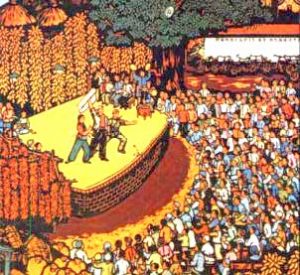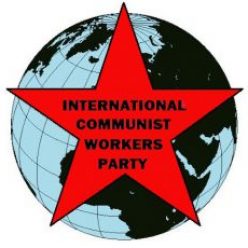USA – In the 1960s and 1970s, some of us participated in a street theater group called the Radical Arts Troop (RAT). It wasn’t communist theater, but it was a wonderful, political educational experience. Talking about it with comrades and friends has helped us think about how film and theater could help mobilize masses for communism.
Our plays lasted only 10-15 minutes. We repeated them several times a day, to fresh audiences. They were funny and had music, but were also serious. They made important political points (like exposing the universities’ role in the Vietnam war).
There was no all-powerful producer. There was a party leader, not a boss. We made decisions by consensus.
We didn’t have stars. There were always heroes and villains, but we took turns. We made sure that no one actor had too much stage time.
We didn’t have auditions. Anybody who liked our politics could join. Everyone would contribute in whatever way they could, or were willing to do. No one was turned away.
We ditched casting by race and gender. Women could play men’s roles and vice versa. We didn’t even have men’s and women’s roles. Except maybe for public figures like Nixon, who could still be played by a woman.
We don’t remember any harassment, although you never know what happens in private. What I am sure of is that RAT did not give anyone the power to coerce anyone else by promising or denying starring roles. There were no starring roles in the first place.
We learned a lot, both individually and collectively, over the course of a couple of years. Our first play took weeks to produce. Writers produced a detailed script and then the actors rehearsed it many times over.
After long experience, we dropped having “writers” and “scripts,” When we needed a new play a self-selected subgroup would work out the basic ideas and jokes. Then we would encourage ad-libbing during rehearsals (and even, with restraint, during performances). Eventually, we could create a play in the evening and perform it the next day if necessary.
We learned to downplay dialogue and rely on big colorful props, loud music, sound effects, and exaggerated gestures. There was no place for subtly raised eyebrows or symbolically ambiguous language.
Sometimes other activists in our campus group didn’t take us seriously. They thought that long, wordy leaflets full of penetrating analysis were more effective than our ‘silly’ plays. They were wrong. Many told us they didn’t really understand some issue until they saw our play.
The biggest strength of our street theater was that it was a great way to get people involved. It’s one thing to read an analysis and agree with it. It can be even more effective to literally act it out in the struggle to win others.
Communist Theater: Now and In the Future
But was RAT communist theater? In aspects of the way it was organized, yes. It was a collective in which everyone contributed according to their ability and commitment.
But in terms of content, no. As its name implies, it was “radical” not communist. We never showed capitalism being overthrown or communism being established. The theories of the time said that RAT had to be radical, not communist. We thought that we needed front groups; that militant, radical struggle will spontaneously produce communists.
Today, we can do much better. Our plays can advocate communism and explain in visual form how our future society will work.
And we don’t have to wait until after the revolution. For instance, we can organize communist skits for our May Day dinners this year that include actors of all ages.
What will theater and film, music and other arts be like in communist society? How will we mobilize masses to participate, not just to be “entertained”? How can communist arts help eliminate sexism and racism and to build mass communist consciousness? Tell us what you think!

The Russian and Chinese revolutions gave birth to a rich history of mass communist entertainment. Hundreds of thousands from the working class participated. Future articles will draw lessons for today from their efforts.


